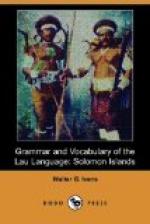PRONOUNS.
The pronouns may be classified as (A) those used as the subject of a verb; (B) those suffixed to a verb or a preposition as object; (c) those suffixed to nouns substantive and denoting possession.
A. PRONOUNS USED AS THE SUBJECT OF A VERB.
Singular:
(1) inau, naut gu.
(2) ioe, oe, o.
(3) inia, niat nit e.
Plural:
Inclusive: (1) igia, gia; igolu,
golu.
Exclusive: (1) igami, gami,
mi; igamelu, gamelu.
(2)
igamu, gamu; igamolu, gamolu.
(3)
igera, gera, da; idalu, dalu.
Dual:
Inclusive: (1) igoro, goro.
Exclusive: (1) igamere, gamere.
(2)
igamoro, gamoro.
(3)
idarot daro.
1. The longer forms, those with i, are used as possessive pronouns when the suffixed pronoun can not be added: geni inau my wife.
The forms with i are never used by themselves as the subject, but are accompanied by one of the shorter forms: igera da ada ma da si ada na they see but do not see. The three longer forms in the singular are of more or less infrequent use. The initial i is run on to the preceding vowel in pronunciation.
2. All the forms without i are used alone as the subject of the verb. Where there are three forms the second and third are generally used together as subjects: gami mi langi si saetamana we do not know; but the short forms gu, o, mi, mu, da, may be used alone as subjects: gu si saea I do not know. The forms in lu are not used as a trial number, but denote a more restricted number of persons.
3. Nia is used as meaning, there is, it is: efita fe bread nia agamolu, how many loaves have you? It may be used before a proper name as the equivalent to a genitive: ana maaedangi nia Abiathar in the days of Abiathar. When the meaning is, there is, it is, nia is preceded by e: na liqa gera enia ada they have their holes; ma te ai enia i luma there is only one person in the house; with na demonstrative added: nia na that is it, that is so.
4. The form ni is seen in nifai what? where? It occurs in certain phrases as meaning, it is, there is: e uta ro si lio ni agamu how is it ye are of two minds? na light fuana noni ni maa the light of the body it is the eye.
5. The plural sign gi is used with the forms in the plural but not with those ending in lu: gia gi fi dao na we have just come.
6. The forms in the plural third igera and gera are used as equivalent to a plural article: igera na judea the Jews.




